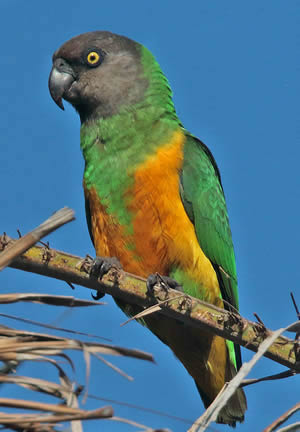Species Description
Senegal Parrots are about 23 cm long, weigh about 125 to 170 gm and they look stocky. They have a relatively large head and beak for their overall size, and feathers form a short broad tail. Adults have a charcoal grey head, grey beak, yellow irises, green back and throat, and yellow underparts and rump. The yellow and green areas on a Senegal Parrot's front form a V-shape resembling a yellow vest worn over green. Juveniles have dark grey, almost black, irises.
Senegal Parrots are not sexually dimorphic, but there are some hypotheses which sometimes might help to determine the gender of adult birds.
The V-shape of the vest is usually longer in females; in females the green area extends down over the chest to between the legs, whereas in males the tip of the green area ends midway down the chest. The female's beak and head are generally slightly smaller and narrower than the male's. The under-tail covert feathers (short feathers under the base of the main tail feathers) are generally mostly yellow in the male and generally mostly green in the female.
Males are generally, but not always, larger and heavier than female birds.
It is a gregarious species, continuously chattering with a range of whistling and squawking calls. Senegal Parrots live an average of approximately 25-30 years in the wild, and have been known to live for 50 years in captivity.
Senegal parrots nest in holes in trees, often oil palms, usually laying three to four white eggs. The eggs are about 3cm long x 2.5cm wide. The eggs are incubated by the female, starting after the second egg has been laid, for about 27 to 28 days. Newly hatched chicks have a sparse white down and they do not open their eyes until about two to three weeks from hatching. They are dependent on the female for food and warmth who remains in the nest most of the time until about four weeks from hatching when the chicks have enough feathers for heat insulation. During this time the male brings food for the female and chicks, and guards the nest site. From about two to four weeks from hatching the female also begins to collect food for the chicks. The chicks fly out of the nest at about 9 weeks and they become independent from their parents at about 12 weeks from hatching.
There are three subspecies. They do not differ in behavior, but only in the color of the "vest". In the pet trade, the nominate subspecies is the most common though all three are raised and sold as pets.
1. Poicephalus senegalus senegalus (the nominate subspecies): this subspecies has a yellow vest; its native range includes southern Mauritania, southern Mali to Guinea and Lobos Island.
2. Poicephalus senegalus mesotypus: this subspecies has an orange vest; its range is from eastern and northeastern Nigeria and Cameroon into southwest Chad.
3. Poicephalus senegalus versteri: this subspecies has a red vest; its range is from the Ivory Coast and Ghana east to western Nigeria.
Habitat
Senegal Parrots are birds of open woodland and savanna.
Distribution
The vast range in Africa






